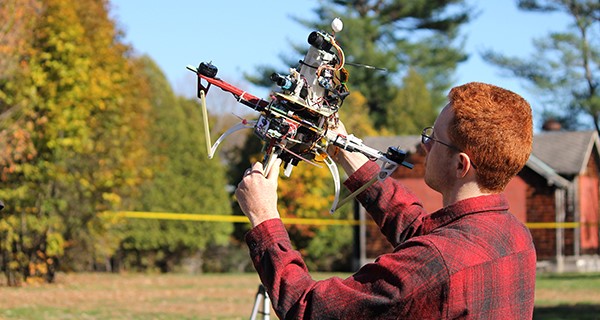DARPA project takes flight in Medfield
November 28, 2016 | by SSCI
November 28, 2016 | by SSCI

Requiring a small and lightweight drone to maneuver quickly through urban terrain may seem straightforward, but add the fact that no GPS or mapping features are used either, and you have yourself a challenge! So just how is the team behind SSCI’s Rapid ADVANCE program doing so far with it?
By Stephen Press
Hometown Weekly Staff
When one hears the words “Defense Advanced Research Projects Agency” (DARPA) and “military research,” one’s thoughts typically start revolving around the exotic, the clandestine, the fantastical. Neutron bombs exploding over desolate salt flats. Laser-wielding cyborgs running through specially-designed obstacle courses. Cold fusion engines powering aircraft as they take off from Area 51.
For his part, Hector Escobar, Senior Research Engineer at SSCI, could only smile. “The way we see it is that it’s more than that,” he said as a quadcopter drone took off nearby. Escobar had come to the Medfield State Hospital with Scientific Systems Company, Inc. (SSCI) to test an autonomous drone as part of a DARPA program. “More than the military,” Escobar continued, “it’s for so many different applications. It feels good to know that we could actually make some progress in technology, not only thinking about military applications, but in general.”
“SSCI’s Rapid Adaptive preDiction for Vision-based Autonomous Navigation and Evasion program (Rapid ADVANCE) is based on a fundamentally new approach to reactive navigation, resulting in very low size, weight, and power requirements for use on small UAVs,” reads a press release from SSCI.com, Scientific Systems Company’s website. “Under the direction of Dr. N. Andrew Browning, the SSCI project is part of DARPA’s Fast Lightweight Autonomy (FLA) program. The aim of this program is to develop and demonstrate the capability for small and fast (20 m/s) UAVs to fly autonomously through complex, cluttered environments.”
Simplified?
“What we basically want to do is have these drones fly autonomously in urban environments like this one. What a perfect environment, like an abandoned city, that we have here,” said Escobar, motioning at the terrain around him. “That’s why we’re actually using the Medfield State Hospital – so we can have actual buildings, actual roads, actual trees. We’re testing our algorithms here.
“The idea is that we have a start point and we have an end goal. We try to fly to it and back, and all autonomously.
“DARPA’s going to provide us a file that says ‘your target is five minutes this way and ten minutes this way,’ and that’s all we know. So then we have to traverse whatever environment they gave us and fly through it. That’s pretty much all we know – where we are and where is our end goal.”
In a nutshell, SSCI is developing a drone that can fly, completely on its own, to and from a given point, avoiding all obstacles on its way.
Oh yeah, and it can’t use GPS.
“The cool thing about this project is that it’s without GPS,” added Escobar. “We’re not using any GPS to navigate, so we’re doing everything visually using several algorithms that we developed.”
It also cannot map the terrain – all of the drone’s processing must be done on the fly.
“The idea of this program is also that it cannot use what is called SLAM, which is simultaneous localization and mapping,” said Escobar. “Most of the drones out there, the research in the universities, they’re doing basically a map. They start creating a map, so by the end of the run, they have a map of all the area.” Nearby, one of SSCI’s drones beeped – not unlike R2-D2 – as it prepared for an autonomous launch.
“We have shorter memory,” said Escobar. “We know where we are and where we’re going, and we can fly, avoiding all the obstacles. But on our way back, we’ll have to avoid them again because we are not [making a map]. That’s to make our algorithms faster and more cost-effective.”
Escobar excused himself to speak with his SSCI team – a crew of six men who had come out to test the fruits of their hours of coding. Grabbing one of the drones, they carried it to a nearby spot for its next run. A few moments later, the craft floated into the air, a pilot standing nearby only in case of emergency. The drone headed skywards, then made a bee-line for a distant spot on the State Hospital grounds. This was a live test, and it seemed to be going swimmingly as the drone’s programmers watched on proudly.
“It is very rewarding, I would say,” concluded Escobar “to see that you programmed something and then you can come out and try it.”

 The Economist magazine highlights SSCI's GPS-denied navigation solution, Im...
The Economist magazine highlights SSCI's GPS-denied navigation solution, Im...